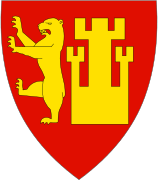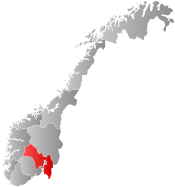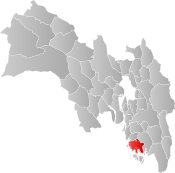Fredrikstad
Fredrikstad (![]()
Fredrikstad kommune | |
|---|---|
 | |
 Flag  Coat of arms  Viken within Norway | |
 Fredrikstad within Viken | |
| Coordinates: 59°12′19″N 10°57′0″E | |
| Country | Norway |
| County | Viken |
| District | Eastern Norway |
| Administrative centre | Fredrikstad |
| Government | |
| • Mayor (2011) | Jon Ivar Nygård (Ap) |
| Area | |
| • Total | 285.9 km2 (110.4 sq mi) |
| • Land | 283 km2 (109 sq mi) |
| Area rank | 283 in Norway |
| Population (30 September 2019) | |
| • Total | 82,301 |
| • Rank | 6 in Norway |
| • Density | 283/km2 (730/sq mi) |
| • Change (10 years) | 8.6% |
| Time zone | UTC+01:00 (CET) |
| • Summer (DST) | UTC+02:00 (CEST) |
| ISO 3166 code | NO-3004 |
| Official language form | Bokmål[1] |
| Website | www |


The city of Fredrikstad was founded in 1567 by King Frederick II, and established as a municipality on 1 January 1838 (see formannskapsdistrikt). The rural municipality of Glemmen was merged with Fredrikstad on 1 January 1964. The rural municipalities of Borge, Onsøy, Kråkerøy, and Rolvsøy were merged with Fredrikstad on 1 January 1994.
The city straddles the river Glomma where it meets the Skagerrak, about 20 kilometres (12 mi) from the Sweden border. Along with neighboring Sarpsborg, Fredrikstad forms the fifth largest city in Norway: Fredrikstad/Sarpsborg. As of 1 January 2018, according to Statistics Norway, these two municipalities have a total population of 136,117 with 80,977 in Fredrikstad and 55,140 in Sarpsborg.
Fredrikstad was built at the mouth of Glomma as a replacement after Sarpsborg (15 kilometres (9 miles) upstream) was burnt down by the Swedish Army in the 1500s. Some of the citizens stayed behind and rebuilt their old town at its original site and got their city status back in 1839.
The city centre is on the west bank of the Glomma, while the old town on the east bank is Northern Europe's best preserved fortified town.
Fredrikstad used to have a large sawmill industry and was an important harbour for timber export, then later on shipbuilding, until the main yard was closed in 1988. The main industries are currently various chemical plants and other light industry.
In 2005, Fredrikstad was the final host port for the Tall Ships' Race, attracting thousands to the city. In 2019, it was the first host port.
In 2017, Fredrikstad won the national award for most attractive city. The award is given yearly by the Norwegian government on the basis of social, economic and environmental factors.[3]
General information
Name
The city was named after the Danish king Frederick II in 1569. The last element stad means "city".
Prior to 1877, the name was spelled Frederiksstad, then from 1877–1888 it was written as Fredriksstad, and finally since 1889 it has been spelled in its current form: Fredrikstad.
Coat-of-arms

The coat-of-arms is from modern times. They were granted on 21 April 1967. The old arms are based on the oldest known seal of the city, which dates from 1610. They showed a fortress being guarded by a bear. Strangely, Fredrikstad had no fortifications in 1610 (it received some at the end of the 17th century). Fredrikstad was founded by citizens of Sarpsborg and both the fortress and the bear are taken from the old arms of Sarpsborg. The composition of the seal was also used as arms since the beginning of the 19th century. The new arms were granted at the 400th anniversary of the city in 1967 and show a more modern variation on the fortress and bear.[4]
History
After Sarpsborg was burned to the ground during the Northern Seven Years' War, the ruling king, Frederik II of Denmark, decided by royal decree to rebuild the city 15 kilometres (9 mi) south of the original location. This new site's proximity to the sea and the accessible open land surrounding it made it a better location than the old one. The name Fredrikstad was first used in a letter from the King dated 6 February 1569. The temporary fortification built during the Hannibal War (1644–1645) between Sweden and Denmark-Norway, became permanent in the 1660s.
The work on the fortifications was first led by Willem Coucheron and later Johan Caspar von Cicignon. During the next 60 years, several fortifications at the Fredrikstad Fortress were built, including Isegran, Kongsten, and Cicignon. In 1735, a suburb on the western side of Glomma, Vestsiden, was founded. This part later grew faster than the old city, and became the dominant city centre. Most of the buildings in the old city burned down during a fire in 1764.
In the 1840s, timber exporting from Fredrikstad started to gain momentum. In the 1860s, several steam powered saws were built along the river, and in 1879 the railway reached Fredrikstad, leading to further growth. With the decline of the timber exports as a result of the modernization of wood-processing industries in the early 1900s, Fredrikstad's production changed to other types of products. It later became one of Norway's most important industrial centres, famous for its large shipyard, Fredrikstad Mekaniske Verksted.
Education
Fredrikstad has three high schools. Frederik II secondary school offering general studies and financial / administrative studies. Frederik II high school is a merger of former Frydenberg gymnastic and Christianslund Handelsgymnasium. Glemmen high school offers professional training and study. Wang Toppidrett Fredrikstad offers sports, science, languages, social sciences and economics. In addition, one finds Steiner, which is a private educational alternative to primary school higher step.
Østfold University College offers higher education (master's and bachelor's studies) at the Academy of Performing Arts, Faculty of Health and Social Care and the Faculty of Engineering at Kråkerøy. Here we also find Østfold College, which offers short professional courses built on a craft / journeyman, authorization or at least five years' experience in technical sciences and health / social science.
Also the Department of Journalism has its seat in Fredrikstad. The department offers primarily continuing education of journalists and editors.
Fredrikstad Museum
Fredrikstad Museum is located in Old Fredrikstad. The museum shows the history of the city and the surrounding region. The museum also manages Elingaard Manor in Onsøy and Torgauten Fort. Fredrikstad Museum was founded in 1903. Since 2003, the museum's management has been located in Tøihuset in Old Town.[5]
Sport
Fredrikstad is home to nine time Norway football winners Fredrikstad FK who play at the Fredrikstad Stadion. It is also the city where the famous and successful manager for the Norwegian national football team Egil Olsen were born and grew up. There is also an American football team, the Fredrikstad Eagles.
Fredrikstad also hosts a number of Norwegian floorball teams, like Slevik IBK, Fredrikstad IBK and St. Croix Pirates.
They also have a hockey team called Stjernen Hockey
Notable residents
- Waldemar Ager, Norwegian-American writer
- Roald Amundsen, Norwegian explorer
- Petronella Barker, Norwegian actress
- Jørn Christensen, Norwegian artist and producer.
- Colin Coates, International Speed Skating Olympian Speed Skating.
- Johan Caspar von Cicignon, General, engineer and city planner
- Johannes Wilhelm Christian Dietrichson, Lutheran Minister
- Tarik Elyounoussi, footballer (soccer), playing for AIK and the Norway national football team
- Albert Andriessen Bradt, Norwegian-American settler in New Netherland
- Jens Gram Jr., barrister and politician
- Stephan Groth, lead singer and founder of Apoptygma Berzerk singer
- Ragnvald Marensius Gundersen, member of Parliament and mayor of Fredrikstad 1945–1965
- Hans Nielsen Hauge, revivalist Norwegian preacher for the Hauge Synod
- Herman Hebler, Norwegian printmaker and graphic artist
- Isabell Herlovsen, footballer (soccer) in the Norway football league.
- Andy LaPlegua, founder of several bands including Combichrist, Icon of Coil, and Panzer AG
- Katti Anker Møller, feminist and advocate for reproductive rights
- Egil "Drillo" Olsen, manager of Norway national football team in the 90s.
- Ole Peter Petersen, founder of Methodism in Norway
- Johan Oscar Smith, Norwegian Christian leader and founder of Brunstad Christian Church
- Dennis Storhøi, Norwegian actor
- Harald Zwart, Norwegian film director
- Bernt Karsten Øksendal, Norwegian mathematician
- Jon Mostad, Norwegian composer
- Jørn Andersen, Norwegian football manager
| Ancestry | Number |
|---|---|
| 2,138 | |
| 1,386 | |
| 1,225 | |
| 828 | |
| 714 | |
| 626 | |
| 501 | |
| 374 | |
| 366 | |
| 341 | |
| 283 | |
| 268 | |
| 253 | |
| 247 | |
| 228 |
International relations
Twin towns – sister cities
The following cities are twinned with Fredrikstad:[7]
| City | Region | Country |
|---|---|---|
| Aalborg[8] | ||
| Húsavík | ||
| Patzún | ||
| San Martín Jilotepeque | ||
| Zhuzhou |
See also
References
Footnotes
- "Forskrift om målvedtak i kommunar og fylkeskommunar" (in Norwegian). Lovdata.no.
- Fredrikstad kommune
- "Fredrikstad kåret til Norges mest attraktive by". www.vg.no (in Norwegian Bokmål). Retrieved 9 October 2019.
- Norske Kommunevåpen (1990). "Nye kommunevåbener i Norden". Retrieved 13 December 2008.
- Fredrikstad museum (Østfoldmuseene Org) Archived 3 April 2015 at the Wayback Machine
- "Immigrants and Norwegian-born to immigrant parents, by immigration category, country background and percentages of the population". ssb.no. Archived from the original on 2 July 2015. Retrieved 24 June 2017.
- "Våre vennskapsbyer" (in Norwegian). Fredrikstad kommune. Archived from the original on 1 December 2007. Retrieved 16 December 2008.
- "Aalborg Twin Towns". Europeprize.net. Archived from the original on 7 September 2013. Retrieved 19 August 2013.
- Hassinen, Raino. "Kotka - International co-operation: Twin Cities". City of Kotka. Retrieved 22 October 2013.
Literature
- Aschehougs Konversasjonsleksikon, Bind 7. H. Aschehoug & Co, Oslo, 1969.
External links
| Wikimedia Commons has media related to Fredrikstad (city). |
| Look up Fredrikstad in Wiktionary, the free dictionary. |

- Bratt Family from Fredrikstad


